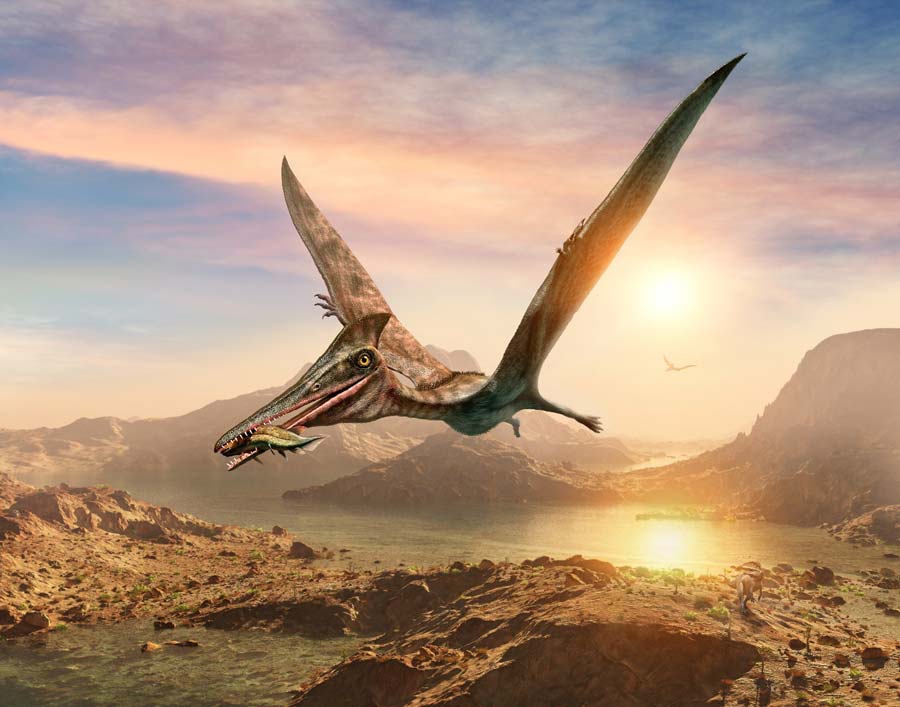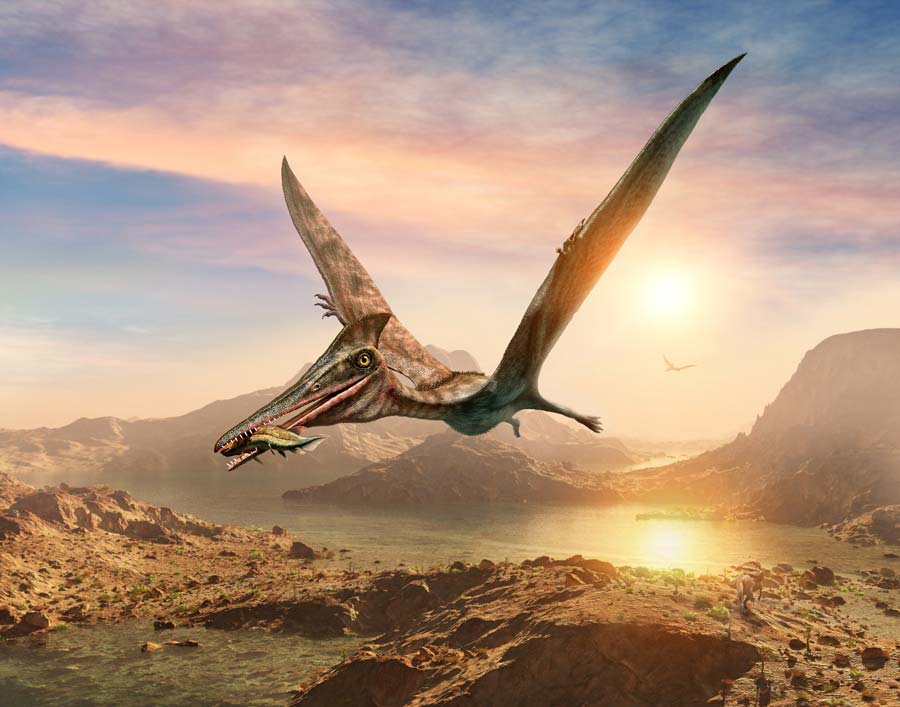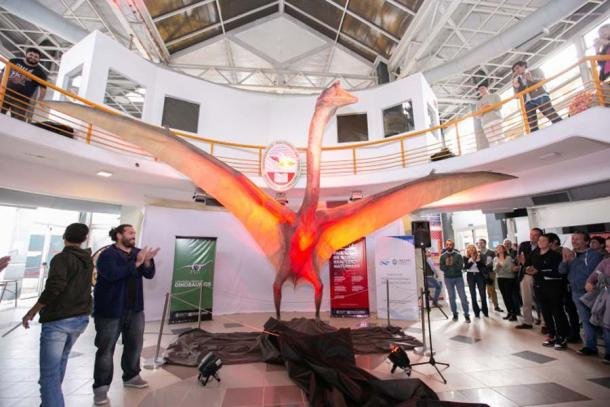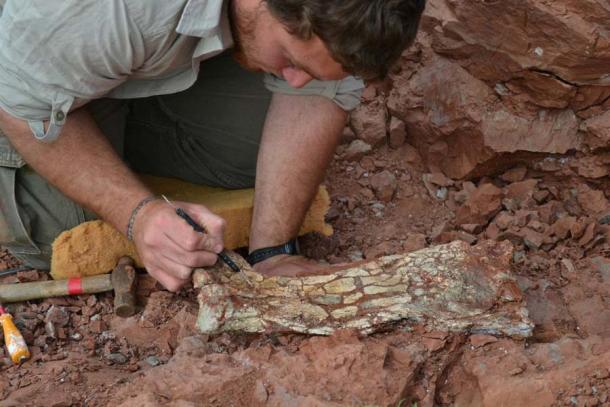

A team of paleontologists have discovered the fossilized remains of a new species of airborne reptile in the Andes Mountains of western Argentina. Dubbed the “Dragon of Death” by its discoverers, this enormous member of the pterosaur family is the largest pterosaur known to have existed in South America in the Cretaceous Period, or, indeed, at any time in the region’s history.
The fossilized bones that allowed this species to be identified for the first time were found in the Argentinian province of Mendoza, which is located along the western coast of Argentina in the country’s mountainous Cuyo region. The recovered bones of the largest pterosaur included several vertebrae and assorted bones of the fore and hind limbs, which were determined to have come from two separate creatures.
At full size these incredible flying reptiles would have had a wingspan that measured 30 feet (nine meters) across, and their bodies would have been a similar length from end to end. In flight it would have been a fearsome sight, soaring high in the sky and blocking out the sun while scanning the ground below for prey to swoop down on and seize.

The unveiling of a one-to-one scale reconstruction of Argentina’s Thanatosdrakon amaru, the largest pterosaur ever found in South America. (Universidad de Cuyo)
Cretaceous Wonder: South America’s Largest Pterosaur Ever!
The onsite excavation of the ancient pterosaur bones was carried out under the leadership of Dr. Leonardo Ortiz David, an Argentinian paleontologist. Dr. Ortiz is a postdoctoral fellow with the FCEN Dinosaur Laboratory and Museum and the Interdisciplinary Institute of Basic Sciences (CONICET), both of which are affiliated with the National University of Cuyo in Mendoza. The excavations he led were originally ordered because of a public works project in the area, and it was necessary to check for fossils or artifacts before this project could continue.
After the initial discovery, Ortiz spent several years analyzing the recovered bones to identify which species they’d belonged to, under the supervision of his doctoral thesis directors, Dr. Bernardo Gonzalez Riga from FCEN and Dr. Alexander Kellner, the Director of the National Museum of Rio de Janeiro in Brazil. Ortiz began this laborious work in 2014, and it was only now in 2022 that Ortiz, Gonzalez, and Kellner finally felt safe in presenting their astounding conclusions to the scientific community, in an article just published in the journal Cretaceous Research.
This remarkable and long-extinct predator of South America’s Cretaceous period has officially been named Thanatosdrakon amaru. Ortiz created this species moniker by combining the Greek words for death (Thanatos) and dragon (drakon).
“It seemed appropriate to name it that way,” he told Reuters. “It’s the dragon of death.”
As for the’ Amaru’, this is the name of a flying serpent or dragon in Andean mythology, sometimes depicted in Inca art with bird-like feet and wings reminiscent of a dragon.
It was determined that the fossilized bones of the largest pterosaur in South America were entombed in a layer of rock that dated to the Cretaceous period, which lasted from 145-66 million years ago. Ortiz and the other scientists estimate that the two Dragons of Death found in the Argentinian Andes would have lived about 86 million years ago, or 20 million years before a nine-mile (14-kilometer) wide asteroid or meteorite smashed into the Yucatan Peninsula (modern-day Mexico) and altered the climate so dramatically that the dinosaurs couldn’t survive.
“We don’t have a current record of any close relative that even has a body modification similar to these beasts,” said Ortiz, stressing the true uniqueness of Thanatosdrakon amaru in comparison to other ancient flying reptiles discovered in the fossil record.

A palaeontologist excavating the bones and fossils that belonged to a newly discovered species of pterosaurs, Thanatosdrakon amaru, in Aguada del Padrillo, Mendoza, Argentina (Leonardo Ortiz David / Universidad de Cuyo)
Remembering the Pterosaurs
Pterosaurs existed on the Earth for more than 160 million years, from approximately 228 million years ago to 66 million years ago. They disappeared along with the dinosaurs, but contrary to popular conception they were not dinosaurs themselves.
“Pterosaurs (flying reptiles) were a very unique group of animals that lived from the Triassic to the Cretaceous and represent the first vertebrates to acquire the ability to actively fly. They are usually confused with dinosaurs, a closely related group,” Ortiz explained in a National University of Cuyo press release.
These animals must have been extraordinarily skilled and prodigious hunters, since they never would have been able to evolve to such impressive dimensions if they’d had any trouble finding food sources.
While Thanatosdrakon amaru is the first of its kind ever found, scientists do know something about its lineage. The Dragon of Death belonged to a group of pterosaurs known as Azharchidae that lived primarily in the Late Cretaceous and were known to reach enormous size. The most well-known member of this group is the largest pterosaur ever found, Quetzalcoatlus, which lived in what is now North America and had a wingspan of about 36 feet (11 meters).
Dinosaur or pterosaur fossils of any kind are difficult to find, because of the immense passage of time and the erosive or destructive forces that can slowly break down and disperse ancient bones over millions of years. But the bones left behind by the two Dragons of Death were remarkably well preserved.
“It is unusual to find numerous large pterosaur bones in a good state of preservation,” Ortiz confirmed. “This aspect is crucial, since Thanatosdrakon preserves elements never before discovered in other giant azhdarchids.”
Because these bone samples were in such good shape, scientists who study them may be able to learn many new details about the anatomy of pterosaurs as a class, and Thanatosdrakon, the largest pterosaur ever found in South America.
It remains uncertain if or when more Thanatosdrakon fossils will be found in Argentina, or elsewhere in South America. But even if they aren’t, paleontologists already know for sure that the species existed, and that they ruled the skies of their homeland 86 million years ago.